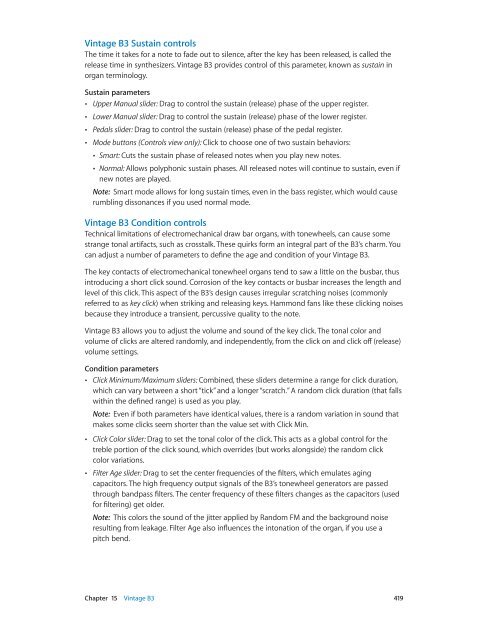Apple MainStage 3 Instruments - MainStage 3 Instruments
Apple MainStage 3 Instruments - MainStage 3 Instruments
Apple MainStage 3 Instruments - MainStage 3 Instruments
Create successful ePaper yourself
Turn your PDF publications into a flip-book with our unique Google optimized e-Paper software.
Vintage B3 Sustain controls<br />
The time it takes for a note to fade out to silence, after the key has been released, is called the<br />
release time in synthesizers. Vintage B3 provides control of this parameter, known as sustain in<br />
organ terminology.<br />
Sustain parameters<br />
••<br />
Upper Manual slider: Drag to control the sustain (release) phase of the upper register.<br />
••<br />
Lower Manual slider: Drag to control the sustain (release) phase of the lower register.<br />
••<br />
Pedals slider: Drag to control the sustain (release) phase of the pedal register.<br />
••<br />
Mode buttons (Controls view only): Click to choose one of two sustain behaviors:<br />
••<br />
Smart: Cuts the sustain phase of released notes when you play new notes.<br />
••<br />
Normal: Allows polyphonic sustain phases. All released notes will continue to sustain, even if<br />
new notes are played.<br />
Note: Smart mode allows for long sustain times, even in the bass register, which would cause<br />
rumbling dissonances if you used normal mode.<br />
Vintage B3 Condition controls<br />
Technical limitations of electromechanical draw bar organs, with tonewheels, can cause some<br />
strange tonal artifacts, such as crosstalk. These quirks form an integral part of the B3’s charm. You<br />
can adjust a number of parameters to define the age and condition of your Vintage B3.<br />
The key contacts of electromechanical tonewheel organs tend to saw a little on the busbar, thus<br />
introducing a short click sound. Corrosion of the key contacts or busbar increases the length and<br />
level of this click. This aspect of the B3’s design causes irregular scratching noises (commonly<br />
referred to as key click) when striking and releasing keys. Hammond fans like these clicking noises<br />
because they introduce a transient, percussive quality to the note.<br />
Vintage B3 allows you to adjust the volume and sound of the key click. The tonal color and<br />
volume of clicks are altered randomly, and independently, from the click on and click off (release)<br />
volume settings.<br />
Condition parameters<br />
••<br />
Click Minimum/Maximum sliders: Combined, these sliders determine a range for click duration,<br />
which can vary between a short “tick” and a longer “scratch.” A random click duration (that falls<br />
within the defined range) is used as you play.<br />
Note: Even if both parameters have identical values, there is a random variation in sound that<br />
makes some clicks seem shorter than the value set with Click Min.<br />
••<br />
Click Color slider: Drag to set the tonal color of the click. This acts as a global control for the<br />
treble portion of the click sound, which overrides (but works alongside) the random click<br />
color variations.<br />
••<br />
Filter Age slider: Drag to set the center frequencies of the filters, which emulates aging<br />
capacitors. The high frequency output signals of the B3’s tonewheel generators are passed<br />
through bandpass filters. The center frequency of these filters changes as the capacitors (used<br />
for filtering) get older.<br />
Note: This colors the sound of the jitter applied by Random FM and the background noise<br />
resulting from leakage. Filter Age also influences the intonation of the organ, if you use a<br />
pitch bend.<br />
Chapter 15 Vintage B3 419
















